Effect of Deposition Parameters and Deposition Height on the Microstructure and Properties of Laser–Cold Metal Transfer Composite Additively Manufactured 2319 Aluminum Alloy
Abstract
1. Introduction
2. Materials and Experiments
3. Results and Discussion
3.1. Characterization of Single-Pass Morphology and Parameter Selection
3.2. Microstructure
3.2.1. Grain Structure
3.2.2. The Second Phase
3.3. Mechanical Properties
3.3.1. Microhardness
3.3.2. Tensile Properties and Fracture Morphology
4. Conclusions
- (1)
- The crack-free 2319 alloy thin-walled sample was fabricated utilizing the laser-CMT composite additive manufacturing technique, achieving a material utilization rate of 96.43%. This high material utilization rate aligns with the goal of maximizing additive manufacturing materials, enhancing its overall efficiency and sustainability.
- (2)
- Along construction direction, the segregation of the secondary phase at the grain boundary intensified and its size gradually increased, while its particle density within the grain decreased. Additionally, in the direction of construction, the grain size increases gradually. The Cu element exhibited enrichment in the additive manufacturing sample.
- (3)
- The microhardness of the additive manufacturing samples exhibited a gradual decrease from construction direction, with values reaching 90 HV, 78 HV, and 72 HV, respectively. The mechanical properties also decrease with increasing height. The tensile property also demonstrates a gradual decrease from the bottom to the top, with the highest attainable tensile strength reaching 296 MPa. At the same time, its tensile strength is higher than that of other processes; therefore, the process is feasible. And the 2319 aluminum alloy sheet is successfully prepared using laser-CMT composite additive manufacturing ductile fracture.
Author Contributions
Funding
Institutional Review Board Statement
Informed Consent Statement
Data Availability Statement
Conflicts of Interest
References
- Liu, J.; Xu, Y.; Ge, Y.; Hou, Z.; Chen, S. Wire and arc additive manufacturing of metal components: A review of recent research developments. Int. J. Adv. Manuf. Technol. 2020, 111, 149–198. [Google Scholar] [CrossRef]
- Ford, S.; Despeisse, M. Additive manufacturing and sustainability: An exploratory study of the advantages and challenges. J. Clean. Prod. 2016, 137, 1573–1587. [Google Scholar] [CrossRef]
- Duda, T.; Raghavan, L.V. 3D metal printing technology. IFAC-PapersOnLine 2016, 49, 103–110. [Google Scholar] [CrossRef]
- Thompson, M.K.; Moroni, G.; Vaneker, T.; Fadel, G.; Campbell, R.I.; Gibson, I.; Bernard, A.; Schulz, J.; Graf, P.; Ahuja, B.; et al. Design for Additive Manufacturing: Trends, opportunities, considerations, and constraints. CIRP Ann. 2016, 65, 737–760. [Google Scholar] [CrossRef]
- Bandyopadhyay, A.; Traxel, K.D. Invited review article: Metal-additive manufacturing-Modeling strategies for application-optimized designs. Addit. Manuf. 2018, 22, 758–774. [Google Scholar] [CrossRef] [PubMed]
- Hu, B.; den Ouden, G. Synergetic effects of hybrid laser/arc welding. Sci. Technol. Weld. Join. 2013, 10, 427–431. [Google Scholar] [CrossRef]
- Gu, J.L.; Ding, J.L.; Williams, S.W.; Gu, H.M.; Bai, J.; Zhai, Y.C.; Ma, P.H. The strengthening effect of inter-layer cold working and post-deposition heat treatment on the additively manufactured Al-6.3Cu alloy. Mater. Sci. Eng. A-Struct. Mater. Prop. Microstruct. Process. 2016, 651, 18–26. [Google Scholar] [CrossRef]
- Casalino, G.; Mortello, M.; Leo, P.; Benyounis, K.Y.; Olabi, A.G. Study on arc and laser powers in the hybrid welding of AA5754 Al-alloy. Mater. Des. 2014, 61, 191–198. [Google Scholar] [CrossRef]
- Steen, W.M. Arc augmented laser processing of materials. J. Appl. Phys. 1980, 51, 5636–5641. [Google Scholar] [CrossRef]
- Bunaziv, I.; Akselsen, O.M.; Salminen, A.; Unt, A. Fiber laser-MIG hybrid welding of 5 mm 5083 aluminum alloy. J. Mater. Process. Technol. 2016, 233, 107–114. [Google Scholar] [CrossRef]
- Wang, P. Analysis of Laser-Arc Hybried Additive Manufacturing Process for Aluminum Structures. Master’s Thesis, Dalian University of Technology, Dalian, China, 2016. [Google Scholar]
- Derekar, K.S. A review of wire arc additive manufacturing and advances in wire arc additive manufacturing of aluminium. Mater. Sci. Technol. 2018, 34, 895–916. [Google Scholar] [CrossRef]
- Sun, R.; Li, L.; Zhu, Y.; Guo, W.; Peng, P.; Cong, B.; Sun, J.; Che, Z.; Li, B.; Guo, C.; et al. Microstructure, residual stress and tensile properties control of wire-arc additive manufactured 2319 aluminum alloy with laser shock peening. J. Alloys Compd. 2018, 747, 255–265. [Google Scholar] [CrossRef]
- Liu, M. Research on Laser-Arc Hybrid Additive Manufacturing of Aluminum Alloy Thin-Wall. Master’s Thesis, Dalian University of Technology, Dalian, China, 2019. [Google Scholar]
- Yu, Q. Study on Laser-Arc Hybrid Additive Manufacturing for Block Structure of Aluminum Alloy. Master’s Thesis, Dalian University of Technology, Dalian, China, 2019. [Google Scholar]
- Liu, D. Research on Laser-TIG Hybrid Additive Manufacturing Process and Mechanical Properties of 2219 Aluminum Alloy. Master’s Thesis, Dalian University of Technology, Dalian, China, 2020. [Google Scholar]
- Sun, C. Research on Forming Characteristics of Thin-Wall AluminiumAlloy Parts by Laser Assisted MIG Arc Additive Manufacturing. Master’s Thesis, Dalian University of Technology, Dalian, China, 2018. [Google Scholar]
- Zhuang, Z.; Song, G.; Zhu, M.; Liu, L. Rapid prototyping of aluminum alloy with vertical deposition by laser-arc hybrid heat source. Trans. China Weld. Inst. 2013, 34, 71–74+116–117. [Google Scholar]
- Ma, Z. Research on Microstructure and Properties of 2319-Al Alloy Withmulti-Layer and Multi-Bead by Laser-induced Arc Additive Manufacturing. Master’s Thesis, Dalian University of Technology, Dalian, China, 2022. [Google Scholar]
- GBT228-2002; General Administration of Quality Supervision, Inspection and Quarantine of the People’s Republic of China. Metallic Materials-Tensile at Ambient Temperature. National Standard of the People’s Republic of China: Beijing, China, 2002.
- Zeng, Q. Research on Process and Performance of Aluminum Alloy Partsby Laser Induced Arc Additive Manufacturing. Master’s Thesis, Dalian University of Technology, Dalian, China, 2020. [Google Scholar]
- Enz, J.; Carrarin, C.; Riekehr, S.; Ventzke, V.; Kashaev, N. Hot cracking behaviour of an autogenously laser welded Al-Cu-Li alloy. Int. J. Adv. Manuf. Technol. 2017, 95, 299–310. [Google Scholar] [CrossRef]
- Wang, S.; Gu, H.; Wang, W.; Li, C.; Ren, L.; Wang, Z.; Zhai, Y.; Ma, P. The Influence of Heat Input on the Microstructure and Properties of Wire-Arc-Additive-Manufactured Al-Cu-Sn Alloy Deposits. Metals 2020, 10, 79. [Google Scholar] [CrossRef]
- Sun, S. Research on Processes and Properties of Alsi10mg Alloy Fabricated by Laser Additive Manufacturing. Master’s Thesis, Shanghai University of Engineering Science, Shanghai, China, 2018. [Google Scholar]
- Gu, J. Study on Microstrure and Mechanical Properties of Additively Manufactured Al-Cu-(Mg) Alloy with the CMT Process. Ph.D. Thesis, Northeastern University, Shenyang, China, 2016. [Google Scholar]
- Faraji, A.H.; Moradi, M.; Goodarzi, M.; Colucci, P.; Maletta, C. An investigation on capability of hybrid Nd:YAG laser-TIG welding technology for AA2198 Al-Li alloy. Opt. Lasers Eng. 2017, 96, 1–6. [Google Scholar] [CrossRef]
- Klein, T.; Arnoldt, A.; Schnall, M.; Gneiger, S. Microstructure Formation and Mechanical Properties of a Wire-Arc Additive Manufactured Magnesium Alloy. JOM 2021, 73, 1126–1134. [Google Scholar] [CrossRef]
- Ma, D.; Xu, C.; Sui, S.; Tian, J.; Guo, C.; Wu, X.; Zhang, Z.; Shechtman, D.; Remennik, S. Enhanced strength-ductility synergy in a wire and arc additively manufactured Mg alloy via tuning interlayer dwell time. J. Magnes. Alloys 2023, 11, 4696–4709. [Google Scholar] [CrossRef]
- Chen, X.; Wang, X.; Huan, P.; Hu, Z.; Wu, Z.; Zhang, B.; Nagaumi, H. Effect of Cold Metal Transfer Mix Synchro-Pulse Process on the Overall Morphology, Microstructure and Mechanical Properties of Wire+ Arc Additively Manufactured AA2219 Alloy. Met. Mater. Int. 2022, 29, 552–563. [Google Scholar] [CrossRef]
- Gu, J.L.; Gao, M.J.; Yang, S.L.; Bai, J.; Ding, J.L.; Fang, X.W. Pore formation and evolution in wire plus arc additively manufactured 2319 Al alloy. Addit. Manuf. 2019, 30, 100900. [Google Scholar] [CrossRef]
- Lei, S. Study on Al-Cu Alloy and Composites Fabricated by Wire Additive Manufactyring. Master’s Thesis, Shanghai Jiao Tong Uiversity, Shanghai, China, 2021. [Google Scholar]
- Gu, T.; Chen, B.; Tan, C.; Feng, J. Microstructure evolution and mechanical properties of laser additive manufacturing of high strength Al-Cu-Mg alloy. Opt. Laser Technol. 2019, 112, 140–150. [Google Scholar] [CrossRef]
- Yu, J.; Wang, J.; Ni, D.; Xiao, B.; Ma, Z.; Pan, X. Microstructure and Mechanical Propertise of Additive Manufactured 2319 Alloy by Electron Beam Freefrom Fabrication. Acta Met. Sin. 2018, 54, 1725–1734. [Google Scholar]
- Fang, X.; Zhang, L.; Li, H.; Li, C.; Huang, K.; Lu, B. Microstructure Evolution and Mechanical Behavior of 2219 Aluminum Alloys Additively Fabricated by the Cold Metal Transfer Process. Materials 2018, 11, 812. [Google Scholar] [CrossRef]
- Li, S.; Zhang, L.J.; Ning, J.; Wang, X.; Zhang, G.F.; Zhang, J.X.; Na, S.J. Microstructures and mechanical properties of Al-Zn-Mg aluminium alloy samples produced by wire plus arc additive manufacturing. J. Mater. Res. Technol. 2020, 9, 13770–13780. [Google Scholar] [CrossRef]
- Zhou, Y.H.; Lin, X.; Kang, N.; Huang, W.D.; Wang, J.; Wang, Z.N. Influence of travel speed on microstructure and mechanical properties of wire plus arc additively manufactured 2219 aluminum alloy. J. Mater. Sci. Technol. 2020, 37, 143–153. [Google Scholar] [CrossRef]
- Yang, K.V.; Shi, Y.; Palm, F.; Wu, X.; Rometsch, P. Columnar to equiaxed transition in Al-Mg(-Sc)-Zr alloys produced by selective laser melting. Scr. Mater. 2018, 145, 113–117. [Google Scholar] [CrossRef]
- Arana, M.; Ukar, E.; Rodriguez, I.; Aguilar, D.; Alvarez, P. Influence of deposition strategy and heat treatment on mechanical properties and microstructure of 2319 aluminium WAAM components. Mater. Des. 2022, 221, 110974. [Google Scholar] [CrossRef]
- Cui, X.; Qi, E.; Sun, Z.; Jia, C.; Zeng, Y.; Wu, S. Wire Oscillating Laser Additive Manufacturing of 2319 Aluminum Alloy: Optimization of Process Parameters, Microstructure, and Mechanical Properties. Chin. J. Mech. Eng. Addit. Manuf. Front. 2022. [Google Scholar] [CrossRef]
- Zhang, Z.; Ma, Z.; He, Z.; Song, G.; Liu, L. Effect of Laser Power on the Microstructure and Mechanical Properties of 2319-Al Fabricated by Wire-Based Additive Manufacturing. J. Mater. Eng. Perform. 2021, 30, 6640–6649. [Google Scholar] [CrossRef]
- Li, R.; Wang, R.; Zhou, X.; Yan, Z.; Huang, J.; Ma, C.; Liu, Y.; Zhang, H.; Ji, R. Microstructure and mechanical properties of 2319 aluminum alloy deposited by laser and cold metal transfer hybrid additive manufacturing. J. Mater. Res. Technol. 2023, 26, 6342–6355. [Google Scholar] [CrossRef]
- Zhu, C.X.; Tang, X.H.; He, Y.; Lu, F.G.; Cui, H.C. Characteristics and formation mechanism of sidewall pores in NG-GMAW of 5083 Al-alloy. J. Mater. Process. Technol. 2016, 238, 274–283. [Google Scholar] [CrossRef]
- Boeira, A.P.; Ferreira, I.L.; Garcia, A. Alloy composition and metal/mold heat transfer efficiency affecting inverse segregation and porosity of as-cast Al-Cu alloys. Mater. Des. 2009, 30, 2090–2098. [Google Scholar] [CrossRef]



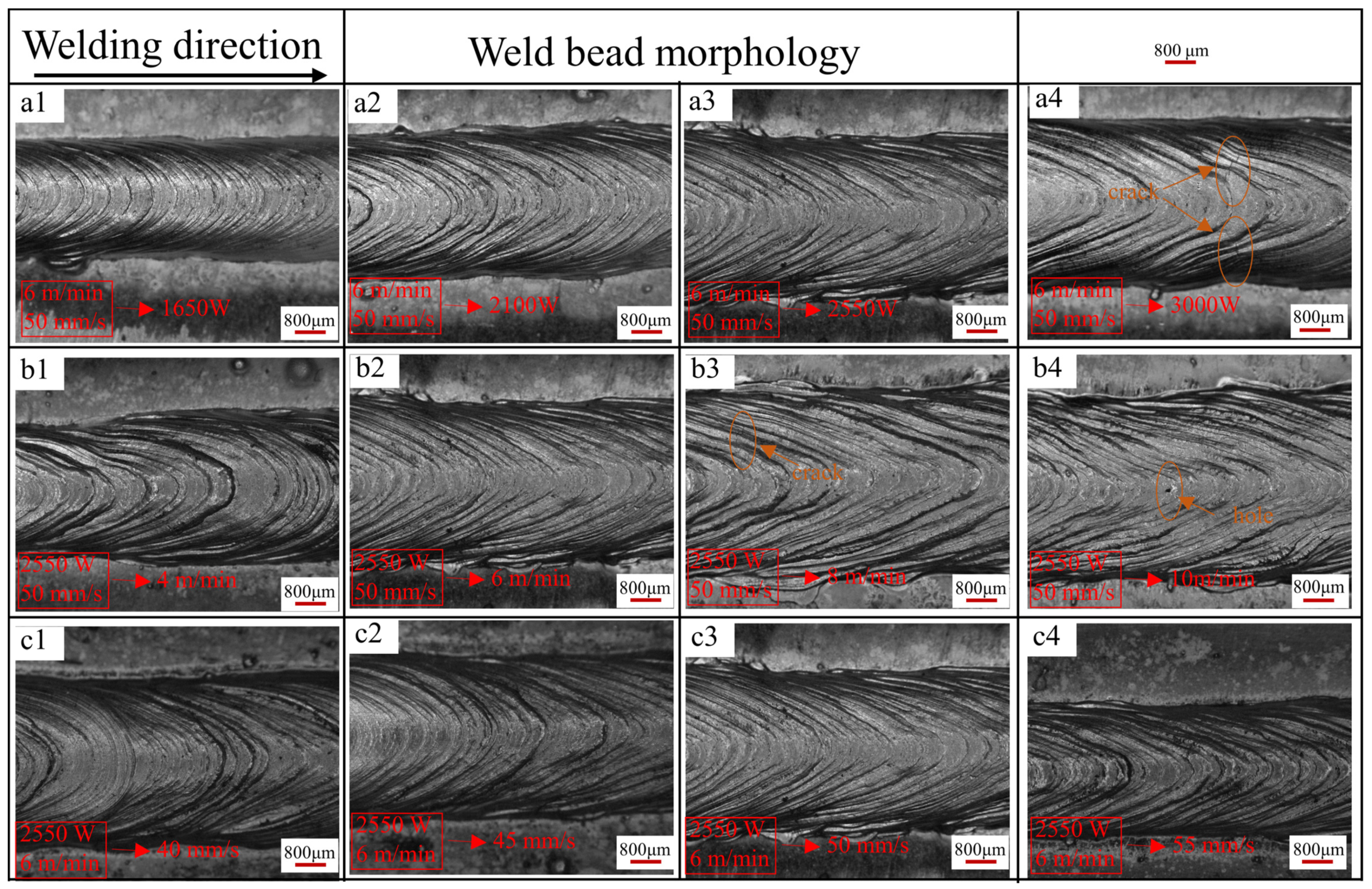
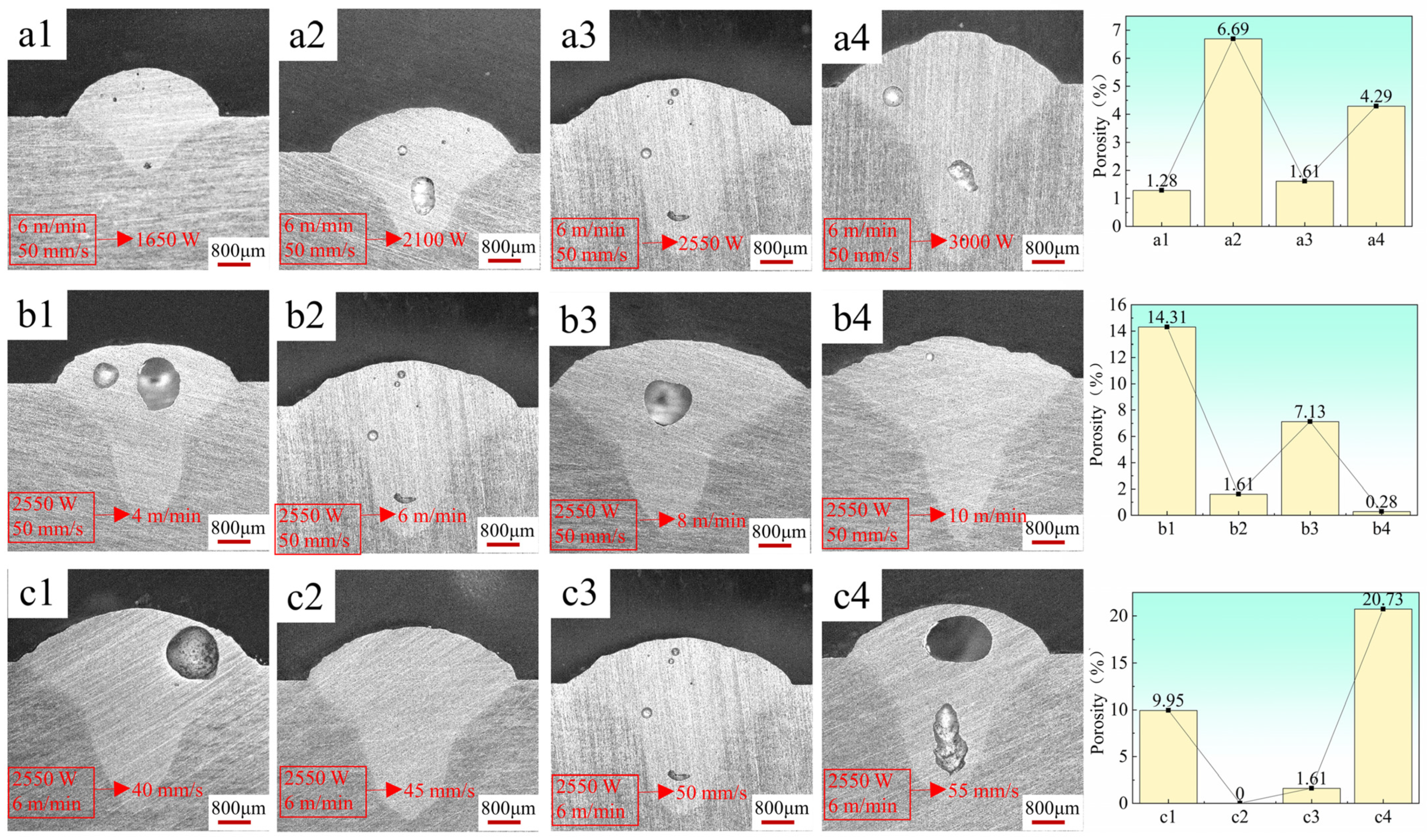
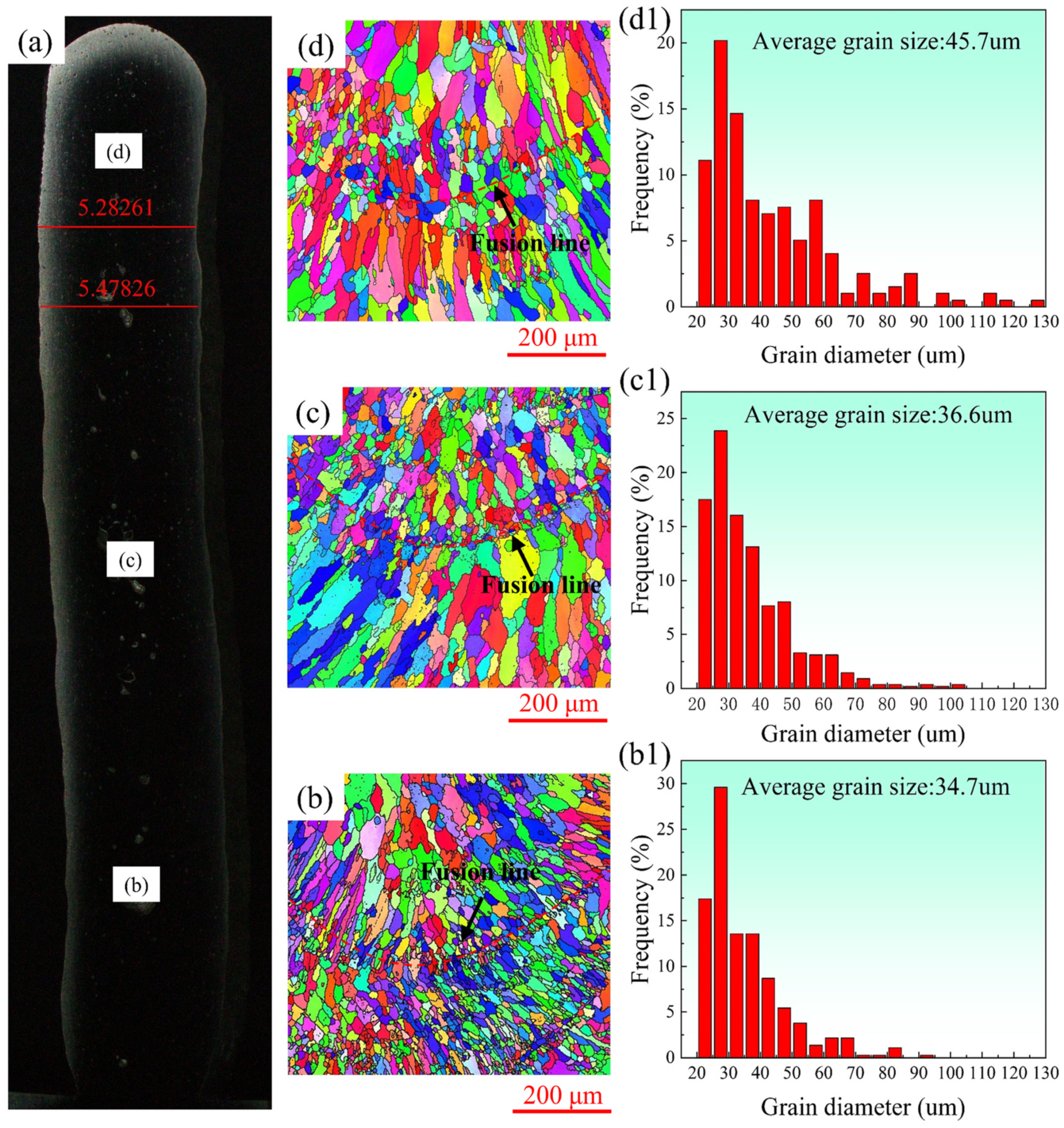
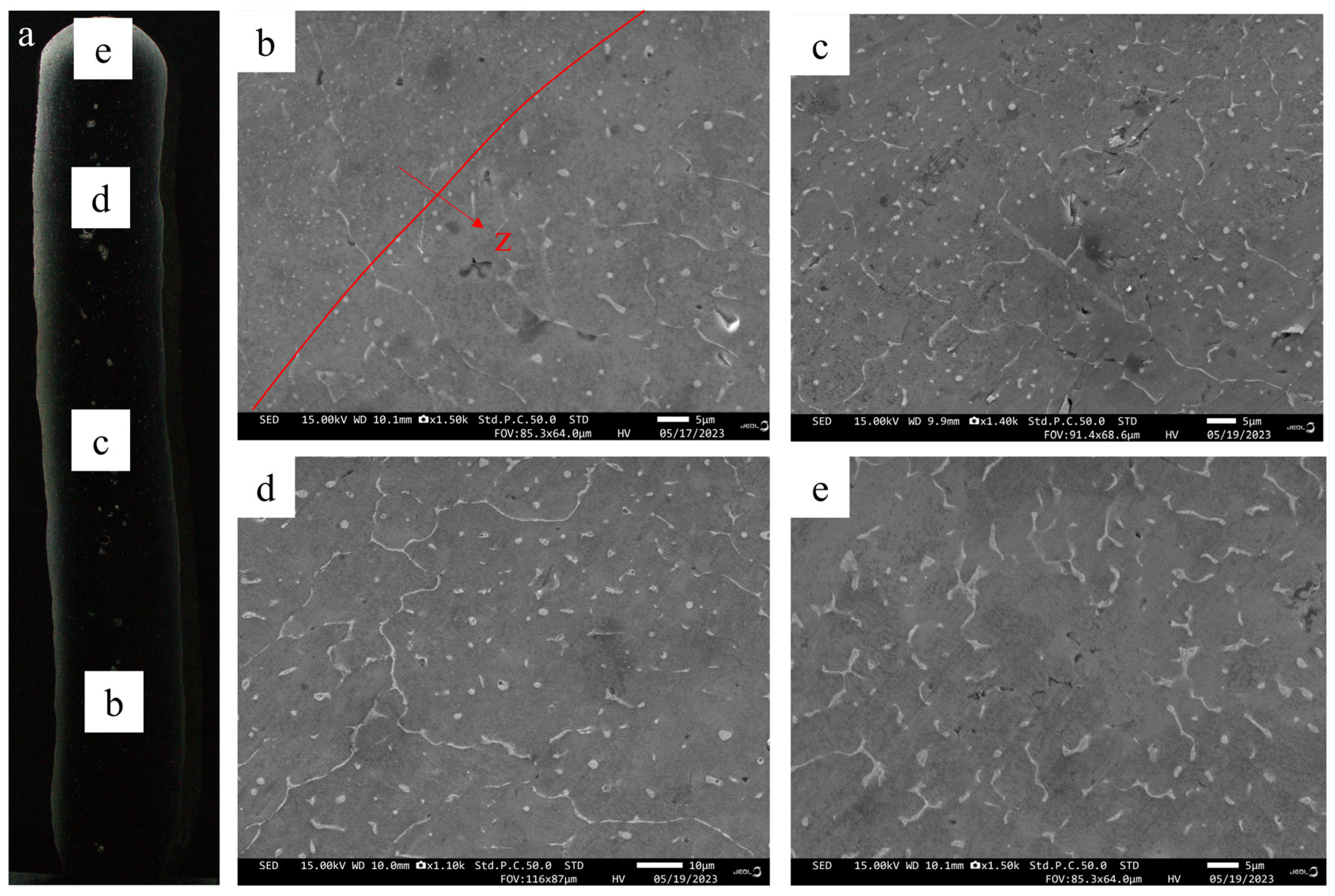


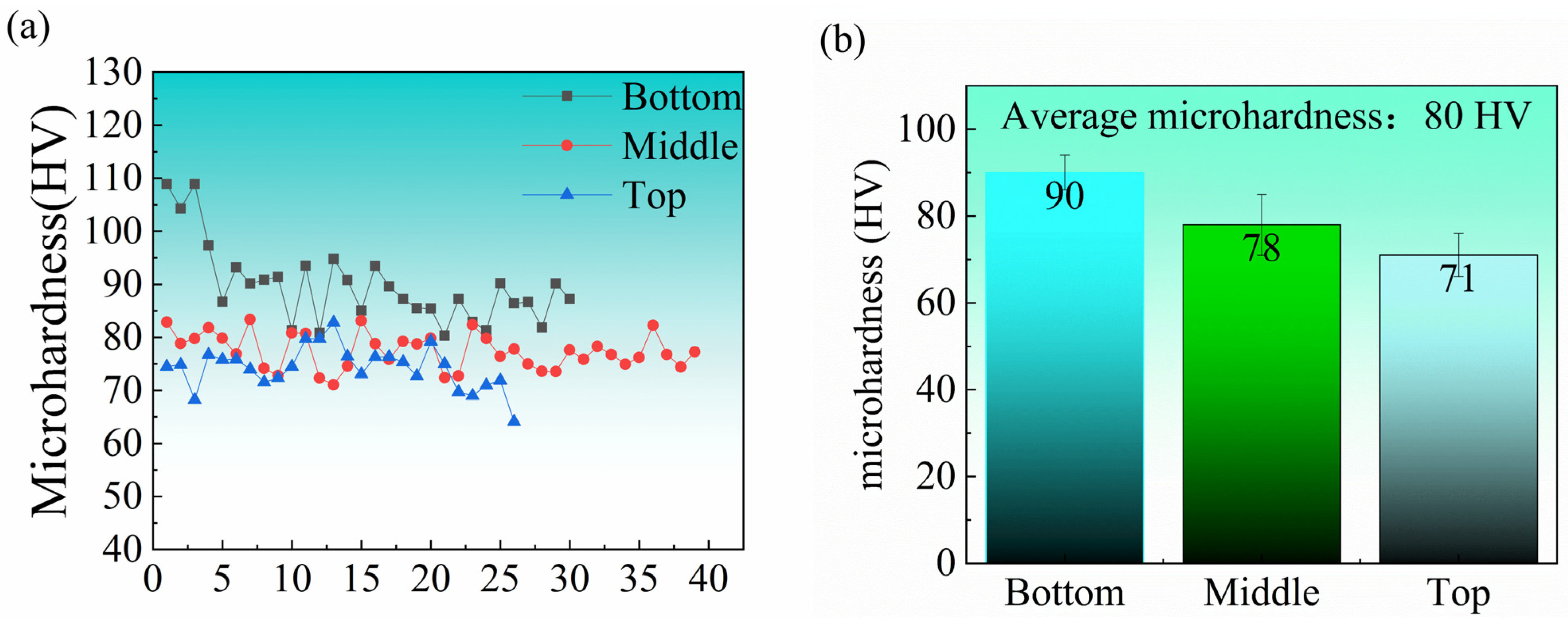
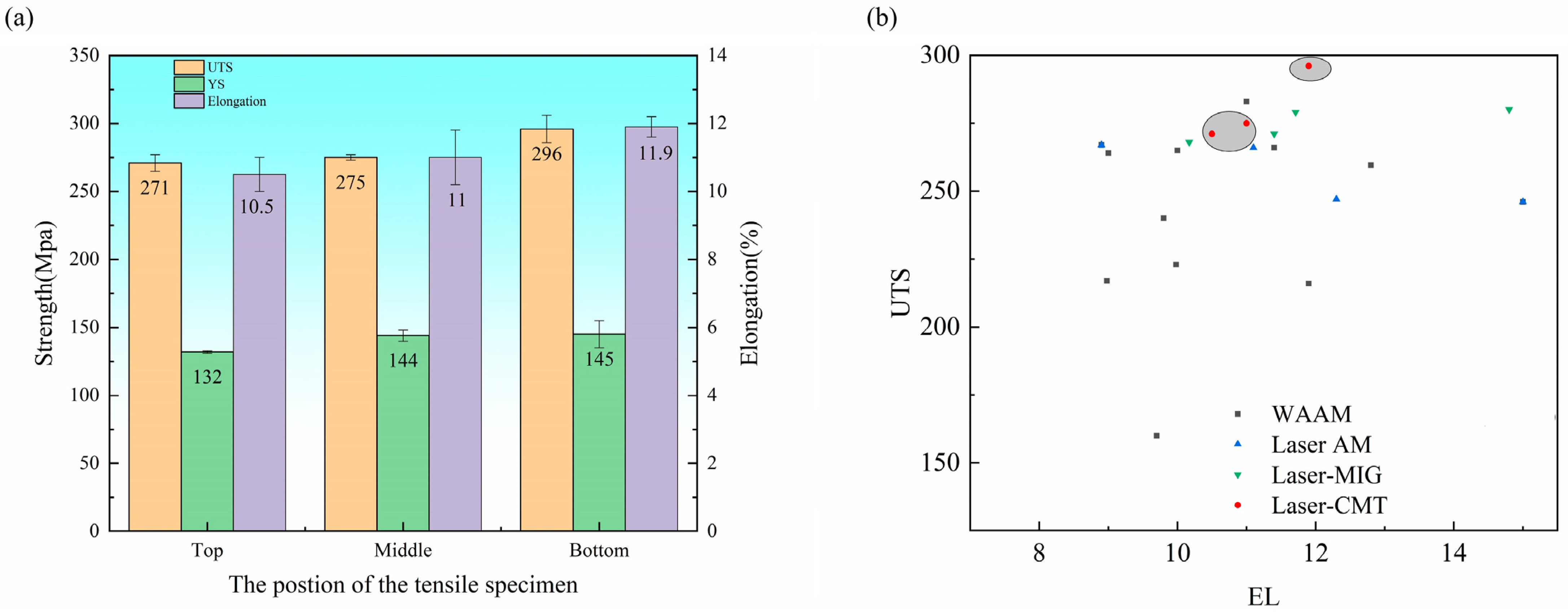

| Materials | Si | Mg | Fe | Mn | Cr | Cu | Zn | Ti | Al | бMax |
|---|---|---|---|---|---|---|---|---|---|---|
| ER2319 | 0.2 | 0.2–0.4 | ≤0.30 | 0.2–0.4 | - | 5.8–6.8 | ≤0.10 | 0.1–0.2 | Bal | 221 |
| AA2219 | 0.2 | 0.2–0.4 | 0.3 | 0.2–0.4 | - | 5.8–6.8 | ≤0.10 | 0.02–0.1 | 400 |
| No. | P (W) | Vf (m/min) | V (mm/s) |
|---|---|---|---|
| a1 | 1650 | ||
| a2 | 2100 | 6 | 50 |
| a3 | 2550 | ||
| a4 | 3000 | ||
| b1 | 4 | ||
| b2 | 2550 | 6 | 50 |
| b3 | 8 | ||
| b4 | 10 | ||
| c1 | 40 | ||
| c2 | 2550 | 6 | 45 |
| c3 | 50 | ||
| c4 | 55 |
| Atlas 1 | Atlas 2 | Atlas 3 | Atlas 4 | Atlas 5 | Atlas 6 | |
|---|---|---|---|---|---|---|
| Al | 75.01 | 74.23 | 90.16 | 87.35 | 89.46 | 91.29 |
| Cu | 24.36 | 21.87 | 9.44 | 12.06 | 10.14 | 8.02 |
| Mg | 0.01 | 0.00 | 0.00 | 0.00 | 0.00 | 0.00 |
| Si | 0.38 | 0.58 | 0.18 | 0.23 | 0.19 | 0.14 |
| Fe | 0.05 | 2.15 | 0.07 | 0.03 | 0.00 | 0.21 |
Disclaimer/Publisher’s Note: The statements, opinions and data contained in all publications are solely those of the individual author(s) and contributor(s) and not of MDPI and/or the editor(s). MDPI and/or the editor(s) disclaim responsibility for any injury to people or property resulting from any ideas, methods, instructions or products referred to in the content. |
© 2024 by the authors. Licensee MDPI, Basel, Switzerland. This article is an open access article distributed under the terms and conditions of the Creative Commons Attribution (CC BY) license (https://creativecommons.org/licenses/by/4.0/).
Share and Cite
Chen, M.; Luo, S.; Chen, X.; Wang, X.; Wu, Z.; Nagaumi, H.; Hu, Z. Effect of Deposition Parameters and Deposition Height on the Microstructure and Properties of Laser–Cold Metal Transfer Composite Additively Manufactured 2319 Aluminum Alloy. Materials 2024, 17, 2914. https://doi.org/10.3390/ma17122914
Chen M, Luo S, Chen X, Wang X, Wu Z, Nagaumi H, Hu Z. Effect of Deposition Parameters and Deposition Height on the Microstructure and Properties of Laser–Cold Metal Transfer Composite Additively Manufactured 2319 Aluminum Alloy. Materials. 2024; 17(12):2914. https://doi.org/10.3390/ma17122914
Chicago/Turabian StyleChen, Mingrui, Shuncun Luo, Xiaming Chen, Xiaonan Wang, Zhikang Wu, Hiromi Nagaumi, and Zengrong Hu. 2024. "Effect of Deposition Parameters and Deposition Height on the Microstructure and Properties of Laser–Cold Metal Transfer Composite Additively Manufactured 2319 Aluminum Alloy" Materials 17, no. 12: 2914. https://doi.org/10.3390/ma17122914
APA StyleChen, M., Luo, S., Chen, X., Wang, X., Wu, Z., Nagaumi, H., & Hu, Z. (2024). Effect of Deposition Parameters and Deposition Height on the Microstructure and Properties of Laser–Cold Metal Transfer Composite Additively Manufactured 2319 Aluminum Alloy. Materials, 17(12), 2914. https://doi.org/10.3390/ma17122914





